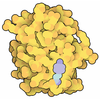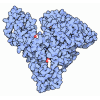[English] 日本語
 Yorodumi
Yorodumi- PDB-7nfb: ER-PRS*(+) (Y537S) in complex with genistein and SRC-2 coactivato... -
+ Open data
Open data
- Basic information
Basic information
| Entry | Database: PDB / ID: 7nfb | ||||||
|---|---|---|---|---|---|---|---|
| Title | ER-PRS*(+) (Y537S) in complex with genistein and SRC-2 coactivator peptide | ||||||
 Components Components |
| ||||||
 Keywords Keywords | TRANSCRIPTION / human estrogen receptor alpha / hERa-LBD / genistein / SRC-2 / ligand binding domain / ER | ||||||
| Function / homology |  Function and homology information Function and homology informationregulation of epithelial cell apoptotic process / RNA polymerase II intronic transcription regulatory region sequence-specific DNA binding / antral ovarian follicle growth / regulation of branching involved in prostate gland morphogenesis / RUNX1 regulates transcription of genes involved in WNT signaling / RUNX1 regulates estrogen receptor mediated transcription / regulation of toll-like receptor signaling pathway / nuclear estrogen receptor activity / epithelial cell development / steroid hormone receptor signaling pathway ...regulation of epithelial cell apoptotic process / RNA polymerase II intronic transcription regulatory region sequence-specific DNA binding / antral ovarian follicle growth / regulation of branching involved in prostate gland morphogenesis / RUNX1 regulates transcription of genes involved in WNT signaling / RUNX1 regulates estrogen receptor mediated transcription / regulation of toll-like receptor signaling pathway / nuclear estrogen receptor activity / epithelial cell development / steroid hormone receptor signaling pathway / prostate epithelial cord elongation / epithelial cell proliferation involved in mammary gland duct elongation / prostate epithelial cord arborization involved in prostate glandular acinus morphogenesis / locomotor rhythm / mammary gland branching involved in pregnancy / uterus development / negative regulation of smooth muscle cell apoptotic process / aryl hydrocarbon receptor binding / vagina development / TFIIB-class transcription factor binding / cellular response to Thyroglobulin triiodothyronine / androgen metabolic process / regulation of glucose metabolic process / Synthesis of bile acids and bile salts / regulation of lipid metabolic process / mammary gland alveolus development / cellular response to estrogen stimulus / estrogen response element binding / Synthesis of bile acids and bile salts via 27-hydroxycholesterol / Endogenous sterols / Synthesis of bile acids and bile salts via 7alpha-hydroxycholesterol / Mitochondrial unfolded protein response (UPRmt) / nuclear receptor-mediated steroid hormone signaling pathway / : / Nuclear signaling by ERBB4 / : / Recycling of bile acids and salts / transcription regulator inhibitor activity / RNA polymerase II preinitiation complex assembly / cellular response to hormone stimulus / positive regulation of nitric-oxide synthase activity / estrogen receptor signaling pathway / protein localization to chromatin / steroid binding / : / 14-3-3 protein binding / positive regulation of adipose tissue development / Regulation of lipid metabolism by PPARalpha / TFAP2 (AP-2) family regulates transcription of growth factors and their receptors / negative regulation of canonical NF-kappaB signal transduction / peroxisome proliferator activated receptor signaling pathway / regulation of cellular response to insulin stimulus / BMAL1:CLOCK,NPAS2 activates circadian expression / SUMOylation of transcription cofactors / response to progesterone / ESR-mediated signaling / negative regulation of miRNA transcription / Activation of gene expression by SREBF (SREBP) / TBP-class protein binding / nitric-oxide synthase regulator activity / nuclear estrogen receptor binding / nuclear receptor binding / transcription corepressor binding / transcription coregulator binding / negative regulation of smoothened signaling pathway / stem cell differentiation / SUMOylation of intracellular receptors / circadian regulation of gene expression / cellular response to estradiol stimulus / mRNA transcription by RNA polymerase II / Heme signaling / euchromatin / Transcriptional activation of mitochondrial biogenesis / PPARA activates gene expression / Activated PKN1 stimulates transcription of AR (androgen receptor) regulated genes KLK2 and KLK3 / Cytoprotection by HMOX1 / beta-catenin binding / Nuclear Receptor transcription pathway / Transcriptional regulation of white adipocyte differentiation / response to estrogen / RNA polymerase II transcription regulator complex / transcription coactivator binding / male gonad development / nuclear receptor activity / positive regulation of fibroblast proliferation / Constitutive Signaling by Aberrant PI3K in Cancer / sequence-specific double-stranded DNA binding / positive regulation of nitric oxide biosynthetic process / Regulation of RUNX2 expression and activity / Ovarian tumor domain proteases / : / response to estradiol / PIP3 activates AKT signaling / HATs acetylate histones / positive regulation of cytosolic calcium ion concentration / MLL4 and MLL3 complexes regulate expression of PPARG target genes in adipogenesis and hepatic steatosis / ATPase binding / PI5P, PP2A and IER3 Regulate PI3K/AKT Signaling / regulation of inflammatory response / DNA-binding transcription activator activity, RNA polymerase II-specific Similarity search - Function | ||||||
| Biological species |  Homo sapiens (human) Homo sapiens (human) | ||||||
| Method |  X-RAY DIFFRACTION / X-RAY DIFFRACTION /  SYNCHROTRON / SYNCHROTRON /  MOLECULAR REPLACEMENT / Resolution: 1.33 Å MOLECULAR REPLACEMENT / Resolution: 1.33 Å | ||||||
 Authors Authors | Kriegel, M. / Muller, Y.A. | ||||||
 Citation Citation |  Journal: Sci Rep / Year: 2021 Journal: Sci Rep / Year: 2021Title: A PROSS-designed extensively mutated estrogen receptor alpha variant displays enhanced thermal stability while retaining native allosteric regulation and structure. Authors: Kriegel, M. / Wiederanders, H.J. / Alkhashrom, S. / Eichler, J. / Muller, Y.A. | ||||||
| History |
|
- Structure visualization
Structure visualization
| Structure viewer | Molecule:  Molmil Molmil Jmol/JSmol Jmol/JSmol |
|---|
- Downloads & links
Downloads & links
- Download
Download
| PDBx/mmCIF format |  7nfb.cif.gz 7nfb.cif.gz | 396.2 KB | Display |  PDBx/mmCIF format PDBx/mmCIF format |
|---|---|---|---|---|
| PDB format |  pdb7nfb.ent.gz pdb7nfb.ent.gz | 285.2 KB | Display |  PDB format PDB format |
| PDBx/mmJSON format |  7nfb.json.gz 7nfb.json.gz | Tree view |  PDBx/mmJSON format PDBx/mmJSON format | |
| Others |  Other downloads Other downloads |
-Validation report
| Summary document |  7nfb_validation.pdf.gz 7nfb_validation.pdf.gz | 1 MB | Display |  wwPDB validaton report wwPDB validaton report |
|---|---|---|---|---|
| Full document |  7nfb_full_validation.pdf.gz 7nfb_full_validation.pdf.gz | 1 MB | Display | |
| Data in XML |  7nfb_validation.xml.gz 7nfb_validation.xml.gz | 25.1 KB | Display | |
| Data in CIF |  7nfb_validation.cif.gz 7nfb_validation.cif.gz | 37 KB | Display | |
| Arichive directory |  https://data.pdbj.org/pub/pdb/validation_reports/nf/7nfb https://data.pdbj.org/pub/pdb/validation_reports/nf/7nfb ftp://data.pdbj.org/pub/pdb/validation_reports/nf/7nfb ftp://data.pdbj.org/pub/pdb/validation_reports/nf/7nfb | HTTPS FTP |
-Related structure data
| Related structure data |  7ndoC 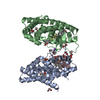 7nelSC S: Starting model for refinement C: citing same article ( |
|---|---|
| Similar structure data | Similarity search - Function & homology  F&H Search F&H Search |
- Links
Links
- Assembly
Assembly
| Deposited unit | 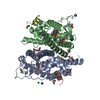
| ||||||||||||
|---|---|---|---|---|---|---|---|---|---|---|---|---|---|
| 1 | 
| ||||||||||||
| Unit cell |
|
- Components
Components
-Protein / Protein/peptide , 2 types, 4 molecules ABCD
| #1: Protein | Mass: 28380.297 Da / Num. of mol.: 2 Mutation: M315I, V316I, D321E, T334S, S341Y, R363K, T371S, C381S, E397D, N407D, N413E, C417S, S433E, M437E, N439K, G442R, S450A, E471N, D473E, H474K, V478M, T485A, H488W, L489Y, A493S, T496S, C530S, Y537S Source method: isolated from a genetically manipulated source Source: (gene. exp.)  Homo sapiens (human) / Gene: ESR1, ESR, NR3A1 / Production host: Homo sapiens (human) / Gene: ESR1, ESR, NR3A1 / Production host:  #2: Protein/peptide | Mass: 1692.981 Da / Num. of mol.: 2 / Source method: obtained synthetically / Source: (synth.)  Homo sapiens (human) / References: UniProt: Q15596 Homo sapiens (human) / References: UniProt: Q15596 |
|---|
-Non-polymers , 6 types, 460 molecules 

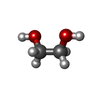

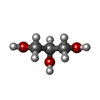






| #3: Chemical | | #4: Chemical | #5: Chemical | ChemComp-EDO / #6: Chemical | #7: Chemical | ChemComp-GOL / | #8: Water | ChemComp-HOH / | |
|---|
-Details
| Has ligand of interest | Y |
|---|---|
| Has protein modification | Y |
-Experimental details
-Experiment
| Experiment | Method:  X-RAY DIFFRACTION / Number of used crystals: 1 X-RAY DIFFRACTION / Number of used crystals: 1 |
|---|
- Sample preparation
Sample preparation
| Crystal | Density Matthews: 2.14 Å3/Da / Density % sol: 42.6 % |
|---|---|
| Crystal grow | Temperature: 292 K / Method: vapor diffusion Details: 200 mM NaCl, 100 mM Tris pH 8.5 and 25% polyethylene glycol 3,350 |
-Data collection
| Diffraction | Mean temperature: 100 K / Serial crystal experiment: N |
|---|---|
| Diffraction source | Source:  SYNCHROTRON / Site: SYNCHROTRON / Site:  BESSY BESSY  / Beamline: 14.2 / Wavelength: 0.9184 Å / Beamline: 14.2 / Wavelength: 0.9184 Å |
| Detector | Type: DECTRIS PILATUS 2M / Detector: PIXEL / Date: May 20, 2019 |
| Radiation | Monochromator: DCM Si(111) / Protocol: SINGLE WAVELENGTH / Monochromatic (M) / Laue (L): M / Scattering type: x-ray |
| Radiation wavelength | Wavelength: 0.9184 Å / Relative weight: 1 |
| Reflection | Resolution: 1.33→27.73 Å / Num. obs: 112549 / % possible obs: 98.86 % / Redundancy: 6.8 % / Biso Wilson estimate: 18.26 Å2 / CC1/2: 1 / CC star: 1 / Rmerge(I) obs: 0.05818 / Rpim(I) all: 0.02386 / Rrim(I) all: 0.06299 / Net I/σ(I): 15.87 |
| Reflection shell | Resolution: 1.33→1.378 Å / Redundancy: 6.8 % / Rmerge(I) obs: 2.094 / Mean I/σ(I) obs: 0.84 / Num. unique obs: 11151 / CC1/2: 0.36 / CC star: 0.728 / Rpim(I) all: 0.8632 / Rrim(I) all: 2.269 / % possible all: 98.49 |
- Processing
Processing
| Software |
| |||||||||||||||||||||||||||||||||||||||||||||||||||||||||||||||||||||||||||||
|---|---|---|---|---|---|---|---|---|---|---|---|---|---|---|---|---|---|---|---|---|---|---|---|---|---|---|---|---|---|---|---|---|---|---|---|---|---|---|---|---|---|---|---|---|---|---|---|---|---|---|---|---|---|---|---|---|---|---|---|---|---|---|---|---|---|---|---|---|---|---|---|---|---|---|---|---|---|---|
| Refinement | Method to determine structure:  MOLECULAR REPLACEMENT MOLECULAR REPLACEMENTStarting model: 7NEL Resolution: 1.33→27.73 Å / SU ML: 0.1763 / Cross valid method: FREE R-VALUE / σ(F): 1.34 / Phase error: 21.3446 Stereochemistry target values: GeoStd + Monomer Library + CDL v1.2
| |||||||||||||||||||||||||||||||||||||||||||||||||||||||||||||||||||||||||||||
| Solvent computation | Shrinkage radii: 0.9 Å / VDW probe radii: 1.11 Å / Solvent model: FLAT BULK SOLVENT MODEL | |||||||||||||||||||||||||||||||||||||||||||||||||||||||||||||||||||||||||||||
| Displacement parameters | Biso mean: 26.75 Å2 | |||||||||||||||||||||||||||||||||||||||||||||||||||||||||||||||||||||||||||||
| Refinement step | Cycle: LAST / Resolution: 1.33→27.73 Å
| |||||||||||||||||||||||||||||||||||||||||||||||||||||||||||||||||||||||||||||
| Refine LS restraints |
| |||||||||||||||||||||||||||||||||||||||||||||||||||||||||||||||||||||||||||||
| LS refinement shell |
|
 Movie
Movie Controller
Controller


 PDBj
PDBj



